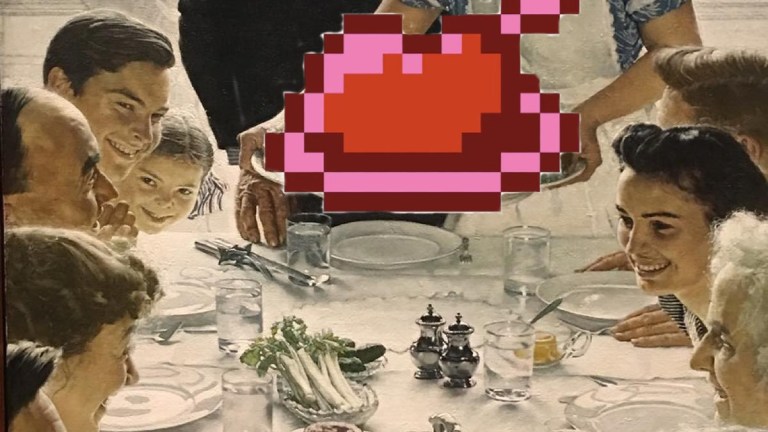How Food Became the Most Iconic Video Game Powerup
From fruit found in mazes to restaurant-quality dinners, food has long been gaming's most reliable and important powerup.

Some of the earliest art showcases packs of cavemen hunting down tasty mammoths. As art was refined over centuries of evolution, food remained both a popular subject and a source of inspiration.
Guiseppe Acromboldo painted human figures made out of fruits and veggies. One of Ang Lee’s best films, Eat Drink Man Woman, features lovingly shot scenes of elaborate meals. And who’s mouth hasn’t watered at the sumptuous depictions of food in a Ghibli film? Food remains a prominent part of nearly every art form.
Gaming is no exception. From delicious digital delicacies like Pac-Man’s fruit to Arthur Morgan’s hearty bear stew in Red Dead Redemption 2, food has not only been lovingly portrayed in games for decades but has long served as one of the medium’s most iconic and important powerups.
Eat With Your Eyes
To understand why food shows up in so many games, you first need to consider the power of visual language. Visual language simply means using symbols to send a message. Our brains excel at making deeper connections when looking at an image rather than just simply reading something. You see it all the time with things like traffic lights, brand logos, and even emojis. Similarly, game designers often rely on visual language to communicate otherwise complicated ideas to players. When it comes to symbols, few things get the message across as clearly as food.
You, the player, know that food gives you the fuel you need to persist. Because you have that connection laser-engraved into your brain, game designers use food as a simple way to indicate that an object in a game will allow a player to continue or acquire something important like health and additional resources. That principle has worked as far back as Pac-Man, which used colorful fruits full of bonus points as an incentive for players to risk difficult maneuvers.
From there, the idea of video game food as a visual language only evolved. Games like Burger Time were built entirely around serving food, marking players’ skills by how much food they created rather than how much they collected. The developers cleverly designed enemies to look like things that could go on a burger, which instantly informed players that they could earn extra points by catching them under a patty or bun.
From there, designers continued to push the boundaries of using food as a way to represent complex ideas. Castlevania, Gauntlet, and Streets of Rage used food as the ultimate restorative item to get you back into the fight. Crash Bandicoot, meanwhile, appeals to your inner squirrel by basing your high score on how many fruits you collect in a level. Each of those titles (and many more) showcases why video game food is an especially effective form of visual language. None of those games needed to break their flow with a clunky tutorial message telling you that food could be used to restore your health or advance your progress. You already knew that.
However while those early examples of video game food work well for quick communication, they can often break down when held up to any real scrutiny. For example, why does Dracula, lord of darkness, keep roasted chickens in his walls? Why do mushrooms make Mario bigger? The answer tends to be “Because they’re video games.” While that answer is often good enough for simpler, more mechanically focused titles, it began to fall apart as video games became more elaborate and immersive. However, a new generation of developers would soon show why video game food has the power to do so much more than restore a few hit points.
Home Cookin’
As gaming evolved, so did the idea of food as a vital part of the gameplay experience. We gradually moved away from the notion that video game food is just this thing you’re meant to eat off the ground without asking any questions. Instead, more and more developers began experimenting with the idea that the player should not only be responsible for eating their food but cooking it as well. It’s an idea many of us also encounter as we grow and mature in our own lives.
Every chef knows that cooking a meal enhances your connection to the food itself. We know where the roast chicken came from because we made it. The idea of cooking the food your character would eat soon became a natural extension of an increasingly immersive medium. Even when treated as a sidequest or optional mechanic, that process of gathering and preparing ingredients created new challenges that were often just as compelling as conquering enemies or navigating dangerous obstacles.
The rapidly growing survival genre is perhaps the best example of the appeal of foraging, cooking, and feasting in a game. Those games often treat food and drink as rare necessities designed to force players into the deadliest parts of their digital worlds in search of vital ingredients. At their best, such systems showcase the true power of food as both this necessary part of life and a genuine pleasure in a sometimes dark world.
However, those same systems can be handled poorly. The needy hunger meter in Don’t Starve and the hunger debuffs in games like Starbound can sometimes make finding and cooking food less of a joy and more of a chore. You’re supposed to feel like a rugged survivalist but you end up feeling more like a babysitter or the one roommate responsible enough to shop and cook.
Other games, having learned from such mistakes, use food as a means to upgrade a character or help them progress through the more substantial parts of an adventure. Breath of The Wild, for example, offers rare ingredients and complex dishes that can yield great benefits when exploring dangerous areas. Such games showcase the full impact of food as a power-up. The thrill of finding the right ingredients, the skills needed to put them together in the perfect way, and the joy of finally partaking in your creation are the qualities that make cooking and eating so much more than a necessary part of survival. Games like Breath of the Wild embrace both the necessity and joy of that process.
Of course, video game food can be so much more than just a mechanic. When used properly, it can also be a powerful tool for a game’s narrative and themes.
Every Dish Has a Story to Tell
Food is a cornerstone of so many cultures and legacies. From regional staples to household favorites, every piece of food often tells a story. The same is true in gaming.
Fallout uses strange or unappetizing fare like crispy iguana chunks and expired military rations to remind you that your character is in a desperate situation and needs to take what nutrition they can get. On the other hand, Red Dead Redemption 2 lets players cook hearty meals made from wild game and foraged veggies, furthering the broader thematic idea that this world is plentiful for those who are clever enough to capitalize on it.
Food can also be a handy tool for worldbuilding, as shown by Cyberpunk 2077. While doing jobs across Night City, players can come across processed, synthetic foods like “Eezybeef” or the popular beverage “Nicola” (which is implied to have nicotine as a key ingredient). Meanwhile, outside the city limits, players can expect to enjoy “pizza” topped with roasted locusts and metallic-tasting filtered rainwater. Those distinct dishes showcase the disparity between the cultivated artificiality and rampant capitalism of Night City and the meager (but genuine) lives of the nomads who live out in the badlands. And the fact that real fruit can be sold to vendors at a much higher markup than most other consumables goes a long way to tell players how badly that world’s ecology has been damaged.
Persona 4, on the other hand, uses food as a way to advance its themes of human connection. The game treats communal meals as a window into the inner lives of its characters and their relationships. Players build social connections with their party through picnics, family dinners, or outings to the local ramen shop. Those meals not only offer vital moments to relax between difficult dungeon crawls but the chance to better understand those who fight alongside you.
Food can also be a way to shine a light on a character’s less pronounced traits. For example, in Dragon Age: Origins, players are able to learn more about their party members through conversation, though not every ally reveals themselves so easily. Sten, for instance, is of the Qun’ari: a culture that shuns emotion and sentiment in favor of stoic collectivism. Sten sees himself as a perfect example of that idea. He’s cold, he’s stoic, and he is in complete control of his emotions at all times. He also despises the player’s homeland of Ferelden. Its people are irrational and have no sense of duty. Yet, there is one thing he likes about that strange land: Cookies.
Despite his self-professed pragmatism, he still allows himself such indulgences. An indulgence that is most commonly associated with innocence and childhood at that. It’s a subtle, but brilliant little moment of characterization that adds new depth to what might otherwise be a factory standard “Big, grumpy warrior-man” archetype.
So the next time you’re enjoying a fresh-made sweet roll in Vvardenfell or some monster curry on the planes of Hyrule, take a moment to really savor the dish. Admire the quality of the game design and the well-seasoned art direction. Sample the flavor text, and consider how well this meal pairs with the game’s narrative. Because, like food, games can be many things to many people. A motivator, an accomplishment, a simple sensation, or a window to another culture. Both are made to be experienced and are often at their best when they’re shared with others. And like a skilled team of chefs, game designers work hard to create something that nourishes the mind and soul.
